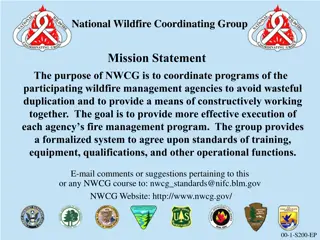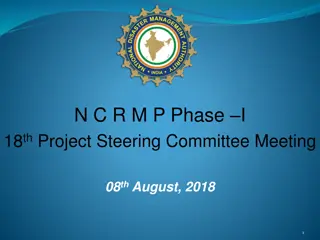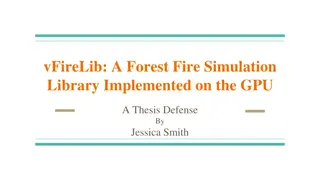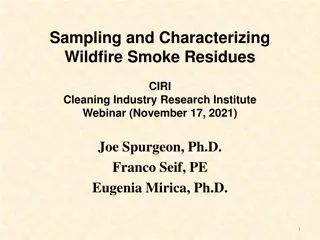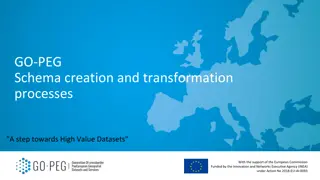Workshop on Tracking Progress of the Mitigation Commitments of Nationally Determined Contributions
Workshop on Tracking Progress of the Mitigation Commitments of Nationally Determined Contributions will focus on enhancing transparency frameworks, modalities, procedures, and guidelines related to NDC tracking provisions. It includes detailed information on mitigation policies, actions, and plans o
1 views • 11 slides
Prescription Development and Scheduling in Wildfire Management
Explore the essential steps involved in developing prescriptions for prescribed fires, including identifying objectives, calculating fire behavior, and setting parameters. Learn about prescription variables, fire modeling outputs, and documentation requirements. Understand the importance of precise
0 views • 25 slides
National Wildfire Coordinating Group (NWCG) - S-200 Initial Attack Incident Commander Course Overview
NWCG aims to enhance coordination among wildfire management agencies to improve fire management program effectiveness. The S-200 course focuses on transitioning from Operations to Command roles, developing leadership skills, incident management, and evaluation techniques. Student evaluation includes
0 views • 12 slides
Virginia Commonwealth University Hazard Mitigation Plan Update
The Virginia Commonwealth University (VCU) Hazard Mitigation Plan (HMP) Update Public Comment Meeting #1 took place on April 5, 2022. The meeting included introductions, overview of hazard mitigation planning, work plan details, data and information needs, next steps, and action items. Various commi
0 views • 20 slides
National Wildfire Coordinating Group - S-270 Basic Air Operations Course
NWCG's mission is to coordinate wildfire management agencies, avoid duplication, and enhance program effectiveness. The S-270 Basic Air Operations course aims to provide a foundational understanding of different aspects of Air Operations, including course logistics, objectives, and reference materia
0 views • 14 slides
Boreal Wildfire Effects and Research Synthesis
The thematic breakout report focuses on the impacts of fire and insect disturbances on the environment, with projects studying wildfires in boreal regions and their effects on ecosystems. Various studies funded by agencies like NASA and ERC aim to understand wildfire vulnerability, resiliency, and c
0 views • 10 slides
Fuego: AI-Based Wildfire Intelligence System Detecting Rapid Wildfire Behavior
Fuego, developed by Fuego Group UC Berkeley and Fireball, is a real-time AI-based system focusing on wildfire behavior in the Wildland-Urban Interface (WUI). The system detects wildfires early, surpassing predictions for 2080 severity. It emphasizes the impact on low-income communities, particularly
1 views • 11 slides
Comprehensive Risk Assessment and Hazard Mitigation Planning
This work delves into risk assessment and hazard mitigation planning supported by the National Science Foundation. It covers the importance of hazard identification, risk assessment, and mitigation planning components. Mitigation actions are outlined to reduce risks to life and property, prevent dam
2 views • 20 slides
Mitigation of DMA-based Rowhammer Attacks on ARM
Practical strategies are presented in "GuardION: Practical Mitigation of DMA-based Rowhammer Attacks on ARM" to defend against Rowhammer attacks on ARM architecture. The paper discusses Rowhammer defenses, RAMPAGE attacks on Android OS, and introduces GuardION as a lightweight mitigation approach. I
0 views • 48 slides
Understanding Wildfire Risk Mitigation Among Private Landowners
Activities involving fuel reduction and defensible space are crucial among private landowners for mitigating wildfire risks. Factors influencing mitigation behavior include wildfire hazard, past experiences, perceived risk, and social context. Information from local government agencies and fire awar
3 views • 15 slides
National Wildfire Risk Assessment and Mitigation Strategies
The National Risk Assessment focuses on identifying and prioritizing hazardous fuels reduction projects to mitigate wildfire risks. Strategic objectives include developing a national risk model and tracking changes over time using a risk index based on national-scale datasets. Leveraging methods out
0 views • 20 slides
Importance of Hazard Mitigation Plans for Scott County
Hazard Mitigation Plans are crucial for Scott County as they allow the county and participating jurisdictions to qualify for FEMA grant funding by minimizing disaster effects before they occur. Scott County has a current plan approved by FEMA, adopted in 2017, and set to expire in November 2022. The
0 views • 26 slides
Wildfire R&D Related Opportunities and Statistics Overview
Comprehensive overview of wildfire-related research and development opportunities, outlining statistics on wildfire suppression costs, fire incidents, and acres affected. The content includes workshop goals, stakeholder needs assessment, and key challenges in the field. Insights from SME inputs, lit
0 views • 18 slides
Wildfire Smoke Exceptional Events Survey Summary
Survey results indicate that staff across various organizations in 11 Western states possess the expertise to develop wildfire smoke exceptional events demonstrations for particulate matter and ozone. The majority of states express readiness to assist other organizations and seek training to enhance
0 views • 17 slides
Lake Brenton Disaster Mitigation Plan Overview
The Lake Brenton Residents Association plays a crucial role in disaster response with defined responsibilities including being the first responder, securing the area, and coordinating with authorities. The Disaster Mitigation Plan for Lake Brenton outlines roles, organizational structure, procedures
1 views • 20 slides
National Cyclone Risk Mitigation Project Phase I Summary
The National Cyclone Risk Mitigation Project (NCRMP) aims to reduce cyclone risk and vulnerability in coastal areas by developing an Early Warning Dissemination System, constructing cyclone risk mitigation infrastructure, and building capacity in coastal communities. Phase I in Andhra Pradesh and Od
0 views • 31 slides
National Cyclone Risk Mitigation Project Update
The National Cyclone Risk Mitigation Project aims to reduce cyclone risks and build resilience in coastal areas through components like Early Warning Dissemination System and Cyclone Risk Mitigation Infrastructure. This update covers progress on awarding contracts, site identification, equipment pro
0 views • 30 slides
Feasibility of Alternate Wetting and Drying as a GHG Mitigation Option in Rice Fields
This synthesis study explores the site-specific feasibility of alternate wetting and drying (AWD) as a greenhouse gas mitigation option in irrigated rice fields in Southeast Asia. The research analyzes the impact of environmental and soil properties on GHG mitigation, evaluates trade-offs and co-ben
1 views • 19 slides
Mitigation and Conservation Banks: A Comprehensive Overview
This content presents insights from Wayne White, President of the National Mitigation Banking Association, regarding the concept of mitigation/conservation banks, their evolution, benefits, agency requirements, and the principles behind their establishment. It emphasizes the importance of market-dri
0 views • 28 slides
vFireLib: Forest Fire Simulation Library on GPU
Dive into Jessica Smith's thesis defense on vFireLib, a forest fire simulation library implemented on the GPU. The research focuses on real-time GPU-based wildfire simulation for effective and safe wildfire suppression efforts, aiming to reduce costs and mitigate loss of habitat, property, and life.
0 views • 95 slides
Comparison of Wet-Wipe and Tape Lift Methods for Sampling Wildfire Smoke Residues
This research study compared the performance of wet-wipe and tape lift sampling methods for evaluating the impact of surface char from wildfire smoke residues. The study involved sampling 48 houses in Southern California affected by different wildfires, utilizing side-by-side replicate samples colle
0 views • 56 slides
Conceptual Design and Risk Assessment of Forced Safety Injection for Station Blackout Accident Mitigation
This study focuses on the application of Forced Safety Injection Tanks (FSITs) for mitigating accidents like Station Blackout (SBO) in nuclear plants. The research analyzes the need for FSITs, compares FSITs with other safety systems, and discusses the operational strategies for FSITs to prevent cor
1 views • 17 slides
Managing Invasive Plants and Wildfire in Arizona
The Invasive Plant Grant Program in Arizona is actively combating invasive plant species to prevent wildfires and preserve ecosystems. State funds are allocated for projects targeting species like Saltcedar and Buffelgrass. Grant criteria and projects in 2019 and 2020 reveal a focus on eradicating n
0 views • 19 slides
Panopticon: Complete In-DRAM Rowhammer Mitigation
Despite extensive research, DRAM remains vulnerable to Rowhammer attacks. The Panopticon project proposes a novel in-DRAM mitigation technique using counter mats within DRAM devices. This approach does not require costly changes at multiple layers and leverages existing DRAM logic for efficient miti
0 views • 17 slides
Sustainable Mitigation Scenarios and Co-benefits for Peru's Long-Term Development
Maria Elena Gutierrez, a Research Coordinator, presented research findings on long-term mitigation scenarios in Peru, including NAMA initiatives, INDC progress, and private sector contributions. The PLANCC model outlined various mitigation scenarios, with the Sustainable Scenario being recommended.
0 views • 14 slides
Assessment Framework for Mitigation Actions: A Tool for NAMA Development
This proposed tool supports the development and management of Nationally Appropriate Mitigation Actions (NAMAs) by providing a structured approach to assess and prioritize different mitigation programs. The tool is designed to assist developing countries, donor countries, and private investors in ev
0 views • 20 slides
Proposed General Fund Budget Mitigation Plan 2024-25
The proposed general fund budget for 2024-25 outlines changes in budget projections, requested increases, mitigation plans, revenue assumptions, and budget allocations for salaries, supplies, and services. Key points include contractual requirements leading to a $16.8 million increase, detailed reve
1 views • 9 slides
Impacts of Climate Change on Wildfire Extremes in Indonesia
A study explores the impacts of climatic and land-use changes on wildfire extremes in Indonesia, focusing on current and future climate-driven fires. The research examines the influence of factors such as drought, economic policies, and adaptation efforts on burned areas, agricultural losses, and la
0 views • 9 slides
NASA Wildfire Management Program Overview
NASA's Applied Science Program focuses on wildfire management efforts through the ROSES-2011.A.35 solicitation, aiming to enhance decision-making and actions related to wildland fires. The program supports research projects, collaborations with the fire community and sister agencies, and outreach ac
0 views • 11 slides
TFRSAC Day 2 Meeting Overview & Objectives
The 35th Tactical Fire Remote Sensing Advisory Committee (TFRSAC) meeting hosted by USDA Forest Service and NASA focuses on advancing wildland management practices and enhancing fire observation capabilities. The agenda includes sessions on AI/ML in support of wildfire management, wildfire decision
0 views • 6 slides
Virginia Commonwealth University (VCU) Hazard Mitigation Plan Update Public Forum
Virginia Commonwealth University (VCU) is updating its Hazard Mitigation Plan to address natural, human-caused, and technological threats affecting the campus. The plan aims to lessen disaster impact, assess vulnerabilities, develop mitigation strategies, and prioritize high-risk areas. VCU's rich h
0 views • 40 slides
Risk Assessment and Hazard Mitigation Overview
This document introduces risk assessment and hazard mitigation planning, supported by the National Science Foundation. It outlines the key components of risk assessment and hazard mitigation planning, emphasizing the importance of identifying and addressing the greatest risks. The process includes h
0 views • 20 slides
Exploring Social and Ecological Factors in Wildfire Recovery on Private Lands
This study delves into the social and ecological aspects influencing wildfire recovery on non-industrial private forest lands post the Labor Day fires. Focusing on NIPF landowners, the research aims to understand the factors shaping resilience and recovery at the landscape level, including the role
0 views • 12 slides
National Wildfire Coordinating Group Mission Statement and Course Objectives
NWCG aims to coordinate wildfire management programs efficiently to enhance execution, avoiding duplication. The course objectives focus on understanding the structure of Expanded Dispatch and developing skills in mobilizing incident resources, effective communication, and fostering positive relatio
0 views • 13 slides
BPA Wildfire Mitigation Program 2022 Public Briefing Overview
The BPA Wildfire Mitigation Program 2022 Public Briefing, held on April 28, 2022, highlighted various aspects including the fire season outlook, wildfire mitigation plan, public safety power shutoff, and strategic management updates. The program aims to address wildfire risks in the BPA service terr
0 views • 18 slides
Proposed Buffer Mitigation Rules Overview
The proposed buffer mitigation rules aim to address nutrient loading by adopting alternative measures to replace lost riparian buffers. The rules include options for location of mitigation, accounting for buffer and nutrient offset, and various optional methods like coastal headwater stream mitigati
0 views • 21 slides
Social Principles Risk Identification and Mitigation Tool Overview
This document outlines the principles and minimum social standards for risk identification and mitigation in programs, focusing on good governance, stakeholder livelihoods, and policy coherence. It provides criteria for assessing risks, including policy risks and actions for mitigation at different
0 views • 15 slides
Mitigating California Wildfires: Hazard Mitigation Grant Program Overview
The Hazard Mitigation Grant Program (HMGP) aims to reduce loss of life and property from future disasters by implementing long-term risk reduction strategies. The program focuses on creating or updating Local Hazard Mitigation Plans, prioritizing post-wildfire mitigation activities, including soil s
0 views • 18 slides
Challenges in High-Value Datasets Creation and Transformation Processes
The creation and transformation process of high-value datasets, such as POP-WILDFIRE, face challenges like schema harmonisation, schema creation, and data transformation. Issues include identifying pan-European datasets, data pre-processing, aligning with INSPIRE directive, and adapting existing met
0 views • 6 slides
California wildfire forces
Sheriff deputies in Malibu were going door to door ordering people to evacuate as a nearby wildfire rapidly intensified, threatening homes in the beach community.
1 views • 24 slides

